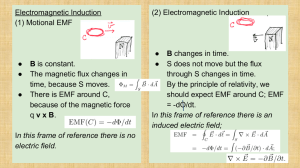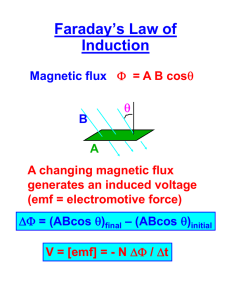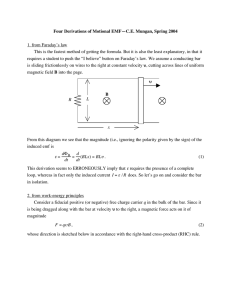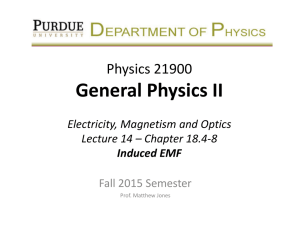Chapter 23 Magnetic Flux and Faraday`s Law of Induction
advertisement
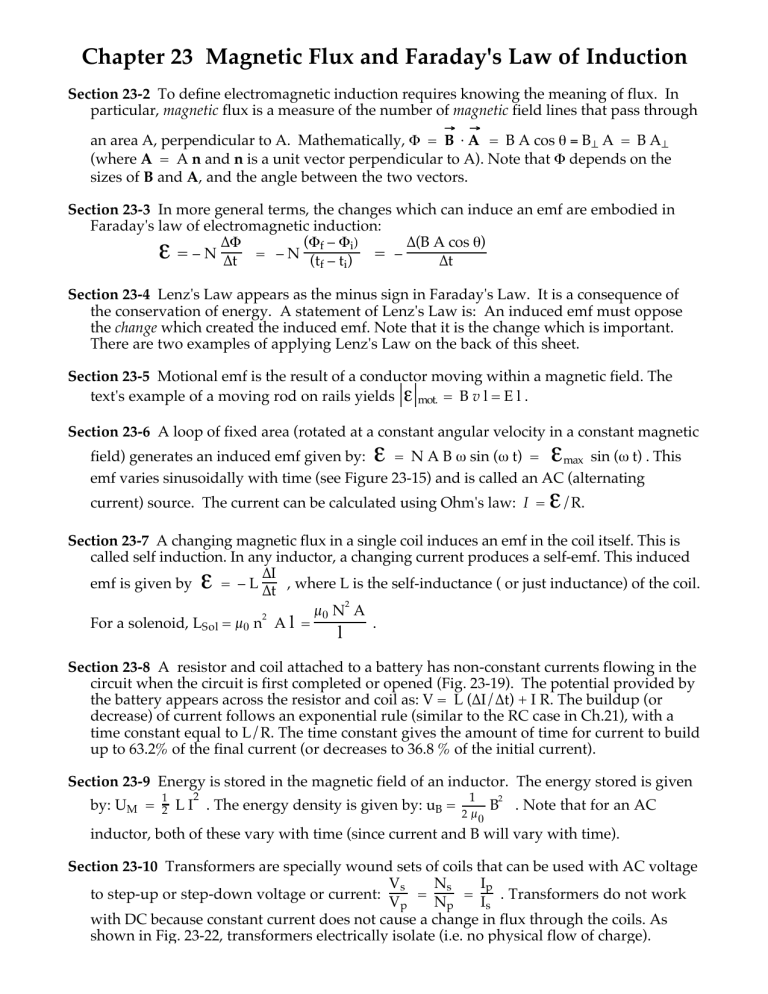
Chapter 23 Magnetic Flux and Faraday's Law of Induction
Section 23-2 To define electromagnetic induction requires knowing the meaning of flux. In
particular, magnetic flux is a measure of the number of magnetic field lines that pass through
→
→
an area A, perpendicular to A. Mathematically, Φ = B · A = B A cos θ = B⊥ A = B A⊥
(where A = A n and n is a unit vector perpendicular to A). Note that Φ depends on the
sizes of B and A, and the angle between the two vectors.
Section 23-3 In more general terms, the changes which can induce an emf are embodied in
Faraday's law of electromagnetic induction:
∆Φ
(Φ – Φ )
∆(B A cos θ)
= – N ∆t = – N (tf – t )i = –
∆t
f
i
ε
Section 23-4 Lenz's Law appears as the minus sign in Faraday's Law. It is a consequence of
the conservation of energy. A statement of Lenz's Law is: An induced emf must oppose
the change which created the induced emf. Note that it is the change which is important.
There are two examples of applying Lenz's Law on the back of this sheet.
Section 23-5 Motional emf is the result of a conductor moving within a magnetic field. The
text's example of a moving rod on rails yields |ε|mot. = B v l = E l .
Section 23-6 A loop of fixed area (rotated at a constant angular velocity in a constant magnetic
ε
ε
field) generates an induced emf given by:
= N A B ω sin (ω t) =
max sin (ω t) . This
emf varies sinusoidally with time (see Figure 23-15) and is called an AC (alternating
current) source. The current can be calculated using Ohm's law: I =
ε/R.
Section 23-7 A changing magnetic flux in a single coil induces an emf in the coil itself. This is
called self induction. In any inductor, a changing current produces a self-emf. This induced
∆I
emf is given by
= – L ∆t , where L is the self-inductance ( or just inductance) of the coil.
2
µ0 N A
2
For a solenoid, LSol = µ0 n A l =
.
ε
l
Section 23-8 A resistor and coil attached to a battery has non-constant currents flowing in the
circuit when the circuit is first completed or opened (Fig. 23-19). The potential provided by
the battery appears across the resistor and coil as: V = L (∆I/∆t) + I R. The buildup (or
decrease) of current follows an exponential rule (similar to the RC case in Ch.21), with a
time constant equal to L/R. The time constant gives the amount of time for current to build
up to 63.2% of the final current (or decreases to 36.8 % of the initial current).
Section 23-9 Energy is stored in the magnetic field of an inductor. The energy stored is given
by: UM =
1
2
2
1
2
L I . The energy density is given by: uB = 2 µ B . Note that for an AC
0
inductor, both of these vary with time (since current and B will vary with time).
Section 23-10 Transformers are specially wound sets of coils that can be used with AC voltage
Vs
Ns
Ip
to step-up or step-down voltage or current: V = N = I . Transformers do not work
p
p
s
with DC because constant current does not cause a change in flux through the coils. As
shown in Fig. 23-22, transformers electrically isolate (i.e. no physical flow of charge).
Lenz's Law
To get the current directions listed below as clockwise (CW) or counter-clockwise
(CCW), we assume the loop is viewed from above. (∆Φ = change in magnetic flux)
ΔΦext →
{
increases
upward
decreases
upward
{
{
1)
ΔΦind
thus
opposes increase
ΔΦind
is downward
→
2)
ΔΦind is downward, thus B ind
is downward
→
3) B ind
1)
is downward, thus I ind is CW.
ΔΦ ind opposes decrease
thus ΔΦind is upward
→
2)
ΔΦind is upward, thus Bind
is upward
→
3) B ind is upward, thus I
Using the same procedure, you should now be able to figure out the results
of
ΔΦext changing in the downward direction.
ind
is CCW.



